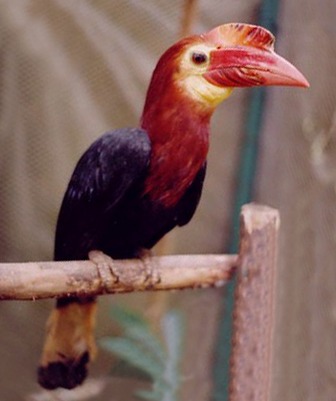Writhed-billed Hornbill
The Rufous-headed Hornbill , also known as the Visayan Wrinkled Hornbill, Walden's Hornbill or Writhed-billed Hornbill, is a critically endangered species of hornbill living in the rainforests on the islands of Negros and Panay in the Philippines. It is closely related to the Writhed Hornbill, but can be recognized by the yellow throat and ocular skin in the male, and the blue throat and ocular skin in the female . Its binomial name commemorates the Scottish ornithologist Viscount Walden.

Original source: Philippine Writhed-billed Hornbill Aceros waldeni. It is called "Dulungan" by the local people.Permission to publish this image was given personally by Callan Bentley. For verifications contact him at callanbentley@hotmail.com. Callan's website is http://www.callanbentley.com where this and other professional quality images are published. Take note however that permission was granted only for this particular image.
Permission: GNU Free Documentation License
The Writhed-billed Hornbill is classified as Critically Endangered (CR), facing an extremely high risk of extinction in the wild.
Wrinkled Hornbill, Walden's Hornbill or Writhed-billed Hornbill, is a critically endangered species of hornbill living in the rainforests on the islands of Negros and Panay in the Philippines. It is closely related to the Writhed Hornbill, but can be recognized by the yellow throat and ocular skin in the male, and the blue throat and ocular skin in the female (both throat and ocular skin are deep orange or red in both sexes of the Writhed Hornbill). Its binomial name commemorates the Scottish ornithologist Viscount Walden. More
Writhed-Billed Hornbill Illustration More
Writhed-billed hornbills use natural or carved-out hollows in tree trunks for their nests. They reproduce very slowly. In conservation camps and parks, man-made nests made of wooden boxes are being attached to tree trunks for the birds to use. The binomial or scientific name commemorates the Scottish ornithologist Viscount Walden. References - * BirdLife International (2006). Aceros waldeni. 2006 IUCN Red List of Threatened Species. IUCN 2006. More
Today, the writhed-billed hornbill (Aceros waldeni) in Panay is virtually extinct. The writhed-bill hornbill is listed by the International Union for the Conservation of Nature and Natural Resources as the world's second most threatened hornbill species. Others - like the Visayan tarictic and the Sulu hornbills - are critically endangered in most of the areas where they survive. More
the writhed-billed hornbill known to locals as dulungan," says Thomas Kuenzel, a German who manages the Philippine Endangered Species and Conservation Project (PESCP). "And there it has survived with a substantial breeding population," he told InterNews&Features. "Whether that population size is viable is another question." "From 2002 until now, there has been a steady increased of the number of nest holes occupied, from 31 to 502 nest holes in 2006," Kuenzel said. More
The writhed-billed hornbills live in small groups and are noisy. Reproduction Writhed-billed hornbills use natural or carved-out hollows in tree trunks for its nest. They reproduce very slowly. In conservation camps and parks, man made nests made of wooden boxes are being attached to tree trunks. The binomial commemorates the Scottish ornithologist Viscount Walden. http://en.wikipedia.org/wiki/Writhed-billed_Hornbill The text in this page is based on the copyrighted Wikipedia article shown in above URL. More
writhed-billed hornbills were discovered and they are currently being guarded with the support of the local public. Moreover, PESCP rescues and releases confiscated highly endangered species. PESCP employees also inform the local public about possibilities of protecting their environment by using new farming methods to stop the illegal poaching of animals and the illegal logging of the primary lowland rainforest. New farming methods result in the amelioration of the local public’s living standards and help save the pristine environment they live in. More

Original source: Emijrpbot
Author: Emijrpbot
Permission: Some rights reserved
Family : Bucerotidae
Genus : Aceros
Species : waldeni
Authority : (Sharpe, 1877)
